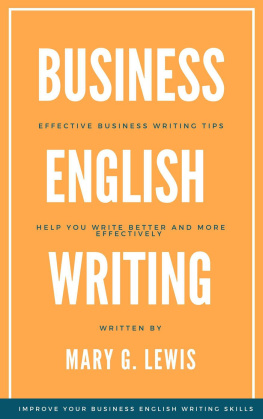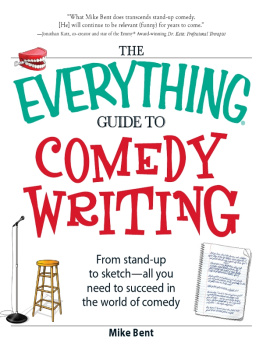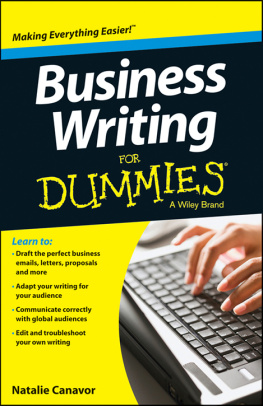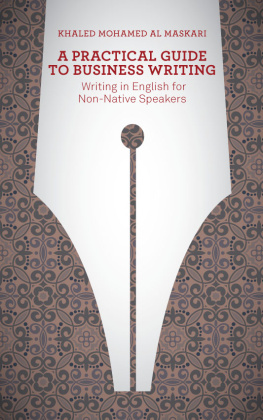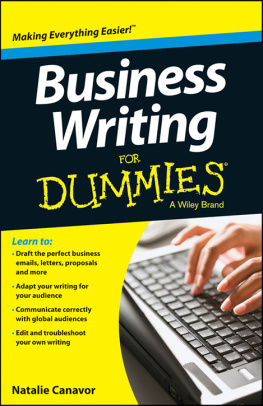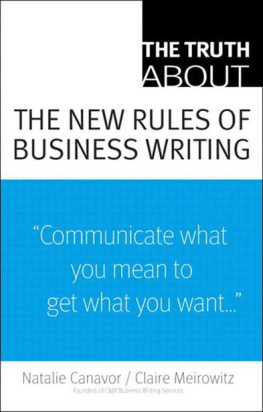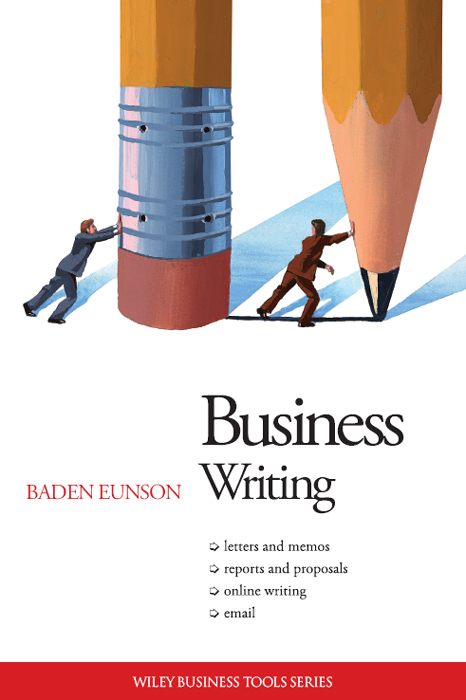Contents

First published in 2007 by
John Wiley & Sons Australia, Ltd
42 McDougall Street, Milton Qld 4064
Office also in Melbourne
Typeset in Berkeley LT 11.3/14.3 pt
Baden Eunson 2007
The moral rights of the author have been asserted
National Library of Australia Cataloguing-in-Publication data:
Eunson, Baden.
Business writing.
Includes index.
ISBN 9781118319680 (pbk.).
1. Business writing. 2. Business communication. I. Title. (Series : Business tools series).
651.74
All rights reserved. Except as permitted under the Australian Copyright Act 1968 (for example, a fair dealing for the purposes of study, research, criticism or review), no part of this book may be reproduced, stored in a retrieval system, communicated or transmitted in any form or by any means without prior written permission. All inquiries should be made to the publisher at the address above.
Cover image Photodisc, Inc.
Author photo David Sheehy
Wiley bicentennial logo: Richard J Pacifico
Disclaimer
The material in this publication is of the nature of general comment only, and does not represent professional advice. It is not intended to provide specific guidance for particular circumstances and it should not be relied on as the basis for any decision to take action or not take action on any matter which it covers. Readers should obtain professional advice where appropriate, before making any such decision. To the maximum extent permitted by law, the author and publisher disclaim all responsibility and liability to any person, arising directly or indirectly from any person taking or not taking action based upon the information in this publication.
Preface
Why bother with communication? Sure, communication is a soft skill that everyone talks about, but is communication that important when you need to be upgrading your skills and knowledge as you are developing your career? Well, actually, it is. All varieties of communication are among the best business tools you can have in your career toolkit.
A 2006 survey by Graduate Careers Australia, Graduate Outlook 2006, found that when employers were looking for graduates to hire, the technical competence of the graduates in their chosen field ran a poor second to the communication skills the employers were primarily looking for.
Much the same considerations apply even if you dont have a degree, or are already in your first or second career time and again, those with good or great communication skills seem to have an advantage over those who dont.
Figure 1: 2006 survey by Graduate Careers Australia factors favoured most by graduate employers

Can such skills be learnt? Of course they can. The book you hold in your hands is part of the Business Tools series, a series that will help you use aspects of communication as tools to further your career, and possibly your own personal development.
Soft skills such as communication in contrast to hard skills, such as number crunching and physical labour are also known as generic, employability or transferable skills. This means that:
- while the technical knowledge you currently have may well be obsolete in five years time, your soft skills will still be relevant in twenty or thirty years time
- the transferable nature of soft skills will help you progress within your organisation and out of your current area of specialisation, and will help you move on to other organisations when the time is right for such a move.
Business Writing provides you with a range of techniques and approaches to writing paper and electronic documents, from memos, letters and reports, to emails and text for websites. I hope you find this book easy to read, and also hope that you can return to it as a tool and resource in your career as a communicator.
Baden Eunson
Melbourne
March 2007
Introduction
Business Writing looks at the different types of documents that are found in the workplaces of today and tomorrow. In the past decade, paper documents such as letters and memos have become less frequently used as email has emerged, but such documents are still important; in some situations in fact, they are more important than they ever were. Some trend predictors have told us that we are now in the age of the paperless office, but this is a myth in most workplaces, there are now more paper documents about than there were previously.
Even when there is no need for hard-copy documents, the techniques of letter and memo writing that you will learn about in this book can be applied when writing any type of document physical or electronic. In fact, some of the techniques of expression and persuasion can also be used in both conversation and presentations.
Good news letters (letters to customers and clients that say yes, we can help you) and bad news letters (letters to customers and clients that say no, we cant help you, but ...) are discussed as well. Various types of persuasive letters, exploring the processes of human motivation along the way, are also considered.
While letters are usually addressed to those outside the organisation, memos are generally addressed to people inside the organisation. Different types of memos for various situations are highlighted in this section, including situations when a hard or paper copy is directly preferable to an email.
I will look also at reports. Reports can be short or long, and can be used for a variety of communication situations. In particular, this chapter focuses on the longer form of the analytical or problem-solving report. Such a complex document presents numerous challenges, and many of your colleagues will do whatever they can to avoid writing reports. Such avoidance is hardly surprising after all, these documents can be a big and time-consuming job. If you take up these challenges, however, and become known as someone who can write excellent reports, it will enhance your reputation considerably.
Finally, I will discuss a close relative of the analytical report the tender, also known as the proposal or submission. A section on online writing closes Business Writing, covering both emails and website text.
Chapter 1
Letters 1 what they are and how to write them
One of the most important elements of business writing is writing letters. You may ask, Why should I bother with such an old-fashioned form of communication as letters? There are many reasons why letters are still utilised; read on to find out why.
Letters when, why and how
Letters are one of a number of genres we use as communicators. With the rise of email, it is commonplace to hear about the death of letter writing in relation to both personal and professional communication. In spite of this, the letter is still very much alive primarily because its advantages still outweigh its disadvantages, which are listed in (overleaf).
: advantages and disadvantages of letter writing as a channel of communication
| Advantages | Disadvantages |
| Official status: many recipients will take a letter, especially on letterhead, more seriously than a fax or email | Time cost. it takes longer to plan, draft, write, edit and send a letter, via mail or courier, than to use email |
| Touch and keep: a letter can be handled, filed and stored without loss of quality |


